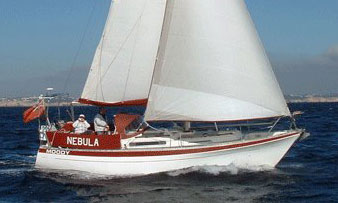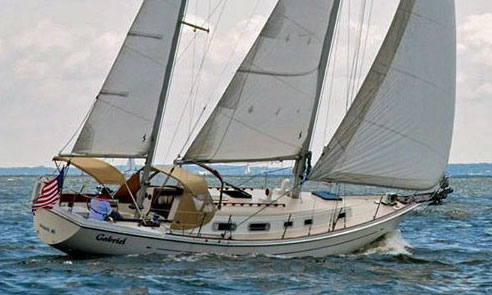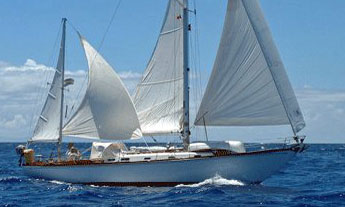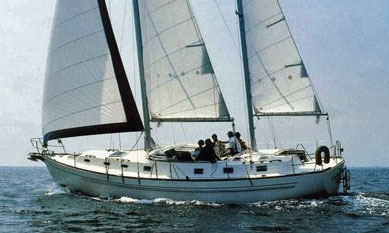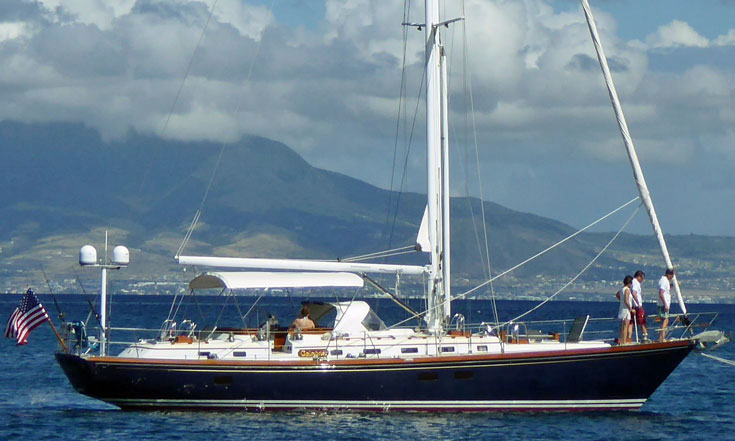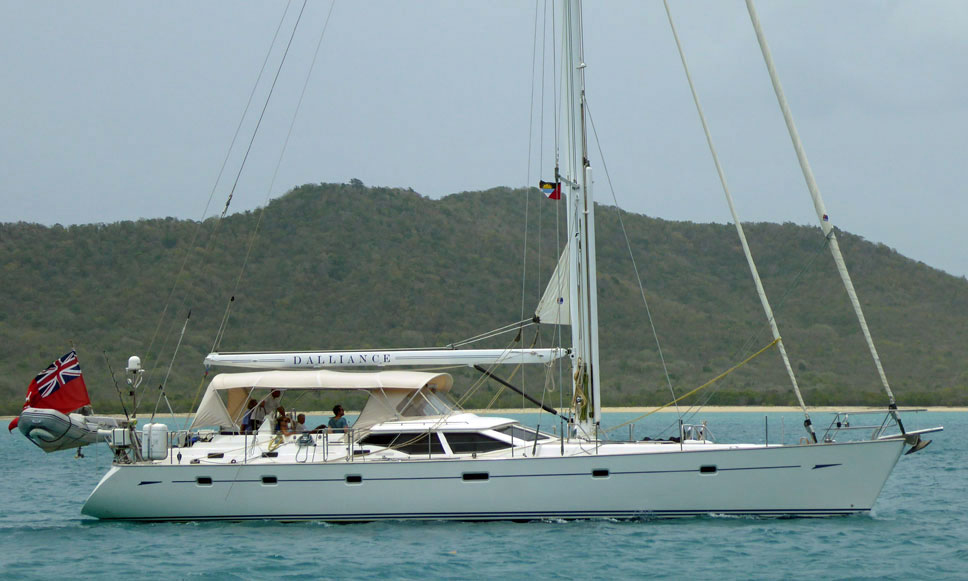- Home
- Cruising Yachts 40' to 45'
- Jouet 1300
The Jouet 1300 Sailboat
Specs & Key Performance Indicators
The Jouet 1300 sailboat was designed by Michel Joubert and manufactured by Yachting France in France throughout the years 1978 to 1984.
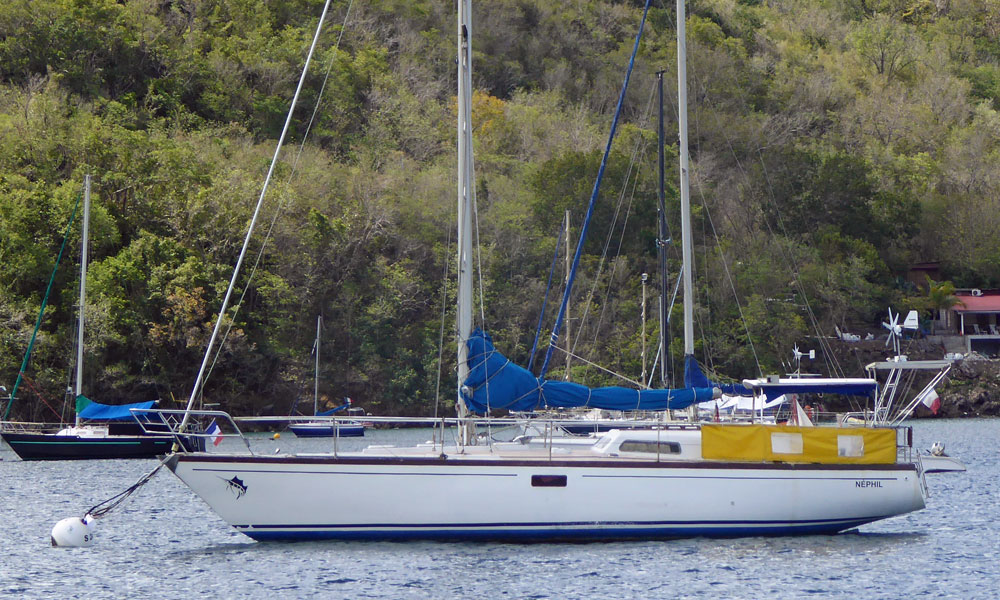 A Jouet 1300
A Jouet 1300Published Specification for the Jouet 1300
- Keel & Rudder Configuration: Fin keel and spade rudder.
- Hull Material: GRP (Fibreglass).
- Length Overall*: 13.00 metres (42'8").
- Waterline Length*: Approximately 10.80 metres (35'5").
- Beam*: 4.10 metres (13'5").
- Draft*: 2.00 metres (6'7").
- Rig Type: Masthead Sloop.
- Displacement*: 9,500 kg (20,944 lbs).
- Ballast*: 3,800 kg (8,378 lbs).
- Sail Area*: 86.00 m² (926 ft²).
- Water Tank Capacity: Not known
- Fuel Tank Capacity: Not known
- Hull Speed: Approximately 8.01 knots. (Calculated using the formula 1.34×LWL in feet, where LWL is 35.45 feet)
- Designer: Michel Joubert.
- Builder: Yachting France.
- Year First Built: 1978.
- Year Last Built: 1984.
- Number Built: Not known
* Used to derive the design ratios referred to later in this article - here's how they're calculated...
Design Options & Alternatives
None known
Sail Areas & Rig Dimensions
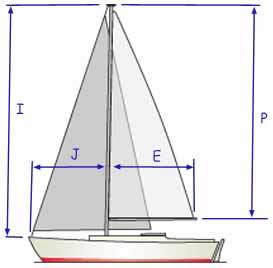 Sail Areas & Rig Dimensions
Sail Areas & Rig DimensionsSail Areas
- Mainsail Area: Approximately 35.00 m² (377 ft²).
- 100% Foresail Area (Jib/Genoa): Approximately 51.00 m² (549 ft²).
Rig Dimensions
- I (Foretriangle Height): 16.50 metres (54'1").
- J (Foretriangle Base): 5.80 metres (19'0").
- P (Mainsail Luff Length): 15.00 metres (49'2").
- E (Mainsail Foot Length): 4.60 metres (15'1").
Published Design Ratios
The Key Performance Indicators (KPIs)
The key design ratios for the Jouet 1300 are:
- Sail Area/Displacement (SA/D) Ratio: 17.58
- Displacement/Length (D/L) Ratio: 227.17
- Ballast/Displacement Ratio: 40.00%
- Capsize Screening Formula (CSF): 1.77
- Motion Comfort Ratio (CR): 33.32
Theoretical Sailing Characteristics
These design ratios offer insights into the Jouet 1300's theoretical sailing performance:
- Sail Area/Displacement (SA/D) Ratio (17.58): This ratio, falling in the mid-to-lower end of the spectrum for cruising boats, suggests the Jouet 1300 is a moderately powered sailboat. An SA/D ratio between 16 and 20 typically indicates a cruiser that will perform adequately in light to moderate winds but might not be a speed demon. It suggests a balance between performance and ease of handling, implying it won't be overly tender in a breeze and will likely be a comfortable cruiser rather than a high-performance racer. It will likely require more wind to get going than a boat with a higher SA/D ratio.
- Displacement/Length (D/L) Ratio (227.17): A D/L ratio in the range of 200-250 generally classifies the Jouet 1300 as a "moderate displacement" cruiser. This implies a boat that is relatively robust and comfortable offshore, capable of carrying stores for extended voyages. It won't be as light and nimble as a performance cruiser, but its moderate displacement contributes to a smoother motion in a seaway and good directional stability. It suggests the boat will have a solid feel and be less prone to hobby-horsing.
- Ballast/Displacement Ratio (40.00%): A ballast ratio of 40% is considered quite healthy for a cruising sailboat. This indicates a good amount of weight concentrated in the keel, contributing significantly to the boat's stability and resistance to heeling. A higher ballast ratio generally means a stiffer boat that can carry more sail in stronger winds without excessive heeling, making for a more comfortable and potentially faster passage in certain conditions. This ratio suggests good initial stability.
- Capsize Screening Formula (CSF) (1.77): A CSF of 1.77 is well below the generally accepted threshold of 2.0 for offshore cruising sailboats. This indicates a very low theoretical susceptibility to capsize in rough offshore conditions. While not a guarantee, it suggests the Jouet 1300 possesses excellent ultimate stability, making it a reassuring choice for ocean passages.
- Motion Comfort Ratio (CR) (33.32): A Motion Comfort Ratio of 33.32 places the Jouet 1300 firmly in the "comfortable offshore cruiser" category. Boats with CRs above 30 are generally considered to have a pleasant motion in a seaway, reducing fatigue for the crew on longer voyages. This indicates a relatively slow and gentle pitching and rolling motion, which contributes to overall comfort, especially when dealing with confused seas.
In summary, based on these design ratios, the Jouet 1300 theoretically presents itself as a robust, stable, and comfortable offshore cruising sailboat. It's designed for safe and relatively comfortable passage-making rather than outright speed. Its moderate sail area and displacement suggest a forgiving nature, while its high ballast ratio and low Capsize Screening Formula indicate excellent stability and offshore capability. The comfort ratio points to a boat that will be pleasant to be aboard even in challenging conditions.
But the Design Ratios Don't Tell the Whole Story...
While design ratios provide valuable theoretical insights into a sailboat's characteristics, they have several significant limitations when used in isolation to define a boat's actual sailing performance:
- Simplification of Complex Hydrodynamics: Ratios are based on simplified formulae and don't account for the intricate interplay of hydrodynamic forces. The actual shape of the hull, keel, and rudder (e.g., fin keel vs. full keel, aspect ratio of the foil) significantly impacts lift, drag, and leeway, which are not captured by basic ratios.
- Lack of Real-World Performance Data: Ratios are theoretical. They don't reflect how a boat performs in various sea states, wind conditions, or with different sail configurations. Actual performance is influenced by factors like wave action, current, crew weight distribution, and trim, which ratios cannot predict.
- Sail Plan Efficiency and Shape: The Sail Area/Displacement ratio uses a simplified "total sail area." It doesn't differentiate between the efficiency of different sail plans (e.g., fractional vs. masthead sloop, cutter rig) or the quality and shape of the sails themselves. A poorly cut sail or an inefficient rig design will negate the benefits suggested by a favourable SA/D ratio.
- Keel and Rudder Design Nuances: While the draft and ballast ratio are included, the specific design of the keel (e.g., aspect ratio, chord length, foil section) and rudder (e.g., balance, area, position) critically affect steering responsiveness, directional stability, and leeway. Two boats with the same draft and ballast ratio could have vastly different handling characteristics due to these design specifics.
- Centre of Effort and Centre of Lateral Resistance (CE/CLR): Ratios do not directly account for the critical relationship between the sail plan's centre of effort and the hull's centre of lateral resistance. The balance between these two points dictates a boat's weather helm or lee helm, which is crucial for handling, steering effort, and overall performance. A well-balanced boat is easier to sail and performs better.
- Construction and Build Quality: The stiffness of the hull, the quality of the rigging, and the overall construction methods significantly impact how a boat performs under stress. A poorly built boat, even with theoretically good ratios, may flex excessively or suffer from structural issues, leading to compromised performance and safety.
- Propeller Drag: For powered sailboats, the presence and design of the propeller create drag, which is not factored into sailing performance ratios. A large, fixed prop can significantly impede performance, particularly in light winds.
- Crew Skill and Experience: Ultimately, a sailboat's performance is heavily influenced by the skill and experience of its crew. How well the sails are trimmed, the course is steered, and the boat is managed in different conditions can drastically alter its perceived characteristics, regardless of its theoretical ratios.
- Subjectivity of "Comfort": While the Motion Comfort Ratio aims to quantify comfort, the perception of comfort is subjective. What one person finds comfortable, another might not.
- Evolution of Design and Materials: Ratios are historical tools. Modern design principles, materials (e.g., lighter and stronger composites), and construction techniques can lead to boats that defy traditional ratio interpretations, achieving higher performance or comfort with seemingly "average" ratios.
In conclusion, while design ratios serve as a useful starting point for comparing theoretical attributes, they should always be interpreted as general guidelines. A comprehensive understanding of a sailboat's characteristics requires considering detailed design drawings, actual performance data, owner reviews, and, ideally, firsthand experience sailing the vessel.
More Specs & Key Performance Indicators for Popular Cruising Boats
Recent Articles
-
Marine Cabin Heaters: The Expert’s Guide to Comfort & Safety at Sea
Dec 05, 25 06:52 AM
Choose the best Marine Cabin Heaters for your vessel. Expert advice on diesel, paraffin, and hot water systems for year-round cruising comfort. -
Marine Water Heating Systems: Free Hot Water from Your Boat's Engine
Dec 03, 25 05:06 PM
Tap into your engine's heat to get free hot water on board. An experienced ocean sailor's guide to marine water heating systems, calorifiers & safety. -
Marine Watermakers: An Offshore Sailor’s Guide & Practical Tips
Dec 03, 25 04:31 AM
Boost your yacht's range with Marine Watermakers. A Yachtmaster's guide to choosing, installing, and maintaining reverse osmosis desalinators for reliable, fresh water on long passages.

